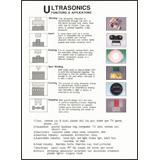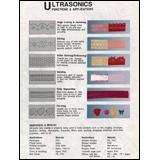Research and Development
Process
Click here for detailsDefinition of Ultrasonic: Sound whose frequency is above the upper range of human hearing.
Ultrasonic welding is an industrial technique whereby high-frequency ultrasonic acoustic vibrations are locally applied to workpieces being held together under pressure to create a solid-state weld. It is commonly used for plastics, and especially for joining dissimilar materials. In ultrasonic welding, there are no connective bolts, nails, soldering materials, or adhesives necessary to bind the materials together.
When applied to materials, these high-frequency vibrations generate enough heat to cut and melt most synthetics without burning. A major benefit of ultrasonic cutting is an exceptionally smooth, clean, sealed edge without the burning associated with conventional heat melting.
Ultrasonic cutting and sealing is achieved by applying ultra-high frequency vibrations (typically in the range of 20-35 KHz) into the material through specially designed tooling. These high-frequency vibrations are produced electronically by an amplifier and horn assembly which are attached to the welding/cutting tool.
Spin welding uses high speed rotational friction and air cylinder pressure from the top to apply heat to the plastic. The machine design rotates the upper product while the bottom product remains stationary on the bottom fixture. After the heat melts the plastic, the once separated parts become one after cooling.
Hot plate welding uses heater pipes inserted into a specially designed hot plate mould usually constructed of aluminum. After the entire heater mould reaches temperatures suitable for welding, the once separated parts are brought together and afterward come in contact with the heater mould in order to melt the joining surface. After the joining surface is melted, the machine itself will then bring the two parts together for joining through air cylinder pressure.
Contact Detail
-
Address2F., No.13, Wuquan 1st Rd., (New Taipei Industrial Park) Xinzhuang Dist., New Taipei City 24892, Taiwan
-
Tel+886-2-2299-5830
-
Fax+886-2-2299-5719
-
E-mail
-
URL

 Ever Green Ultrasonic Co., Ltd.
Ever Green Ultrasonic Co., Ltd.
